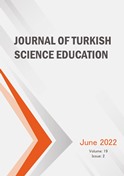A Confirmatory factor analysis of malaysian primary school students’ energy saving practices
DOI:
https://doi.org/10.36681/Keywords:
Confirmatory factor analysis (CFA), energy saving practices, measurement model, primary school studentsAbstract
This paper purposed to validate Malaysian primary school students’ energy saving practices via confirmatory factor analysis. The sample of the study was a total of 401 primary school students, who were selected with randomly cluster sampling method. To collect data, a five-point Likert scale was used. Data were exposed to descriptive analysis (Cronbach’s alpha values for reliability) and a confirmatory factor analysis for testing measurement models for each of the constructs through AMOS software. The results showed that Cronbach’s alpha coefficient was higher than 0.70. The results of the first and second order confirmatory factor analyses (CFA) ensured that the collected data fit with the model. It was also found that the measurement model satisfied specified measurement criteria. Overall, it can be deduced that the extracted components are useful guidelines to increase Malaysian primary school students’ understanding of energy saving practices. Further, this research recommends some implications for future research and practitioners.
Downloads
References
Alpdogan, T. (1996). Air and environmental pollution providing a solution to prevent immediate results: Thermal insulation. Turkey Eng. News, pp. 8–10.
Anne, O. (2012). Act and inspire: The dual roles of schools in environmental protection. Retrieved from http://www.edutopia.org/blog/environmental-ed-lessons-anne-obrien
Arbuckle, J., & Wothke, W. (1999). AMOS 4 user’s reference guide. Chicago: Smallwaters Corp.
Ayvaz, Z. (1991). Energy, economy, entropy, and environmental pollution. J. Ecol, 1(1991), 22–23.
Babbie, E. (2007). The practice of social research. Belmont, California: Thomsom Wadsworth.
Cohen, L. & Manion, L. (1989). Research methods in education (3rd ed.). London: Routledge.
Enerdata. (2017). Global Energy Statistical Yearbook 2017. Retrieved from https://yearbook.enerdata.net/total-energy/world-consumption-statistics.html
Enerdata. (2017). Global energy statistical yearbook 2018. Retrieved from https://yearbook.enerdata.net/total-energy/world-consumption-statistics.html
Golnaz, R., Masoum, H., Mad Nasir, S., Ismail, A. L., & Juwaidah, S. (2015). Effects of go-green campaigns on changing attitude towards green behaviour. Social Sciences and Humanities, 23(8), 77–92.
Gülüzar, E. (2016). Developing energy systems engineering students’ perceptions of renewable energy for sustainable future. Journal of Turkish Science Education, 14(2), 42-51.
Hair, J. F., Anderson, R. E., Tatham, R. L., & Black, W. C. (2010). Multivariate data analysis (4rd ed.). New Jersey: Prentice Hall.
Hair, J. F., Black, W. C., Babin, B. J., Anderson, R. E., & Tatham, R. L. (2006). Multivariate data analysis (6th ed.). New Jersey: Prentice Hall.
Hanifah, M., Shaharudin, I., Mohmadisa, H., Nasir, N. & Yazid, S. (2015). Transforming sustainability development education in malaysian schools through greening activities. Review of International Geographical Education Online (RIGEO), 5(1), 77-94.
Hilal, A. (2011). Determining energy saving behavior and energy awareness of secondary school students according to socio-demographic characteristics. Educational Research and Reviews, 6(3), 243–250.
Ikerne, A. B. (2013). Electricity saving behaviours and energy literacy of New Zealand children. University of Otago, New Zealand.
Intergovernmental Panel on Climate Change (IPCC). (2013). Summary for policymakers. Cambridge, United Kingdom and New York, US: Cambridge University Press.
Invergard, T. B. K. (1976). Ergonomics and the Consumer. Ergonomics, 19(3), 321–329.
Jo, T., Jennifer, A., Lani, W., Lorraine, G., & Thach, S. (2012). Energy saving success stories from Southern California 2011-2012. Washington, DC.
Kate, C. (2013). Powering Down. Antioch University New England: Resource Management and Conservation.
Malaysia Environmental Department (2016). Sekolah Lestari – Environmental Award. Retrieved from http://www.doe.gov.my/portalv1/en/info-umum/sekolah-lestari-anugerah-alam-sekitar/163
Malaysian Green Technology Corporation. (2015). A touch of green: Save money, save energy, save the planet. Retrieved from http://www.themalaymailonline.com/features/article/a-touch-of-green-save-money-save-energy-save-the-planet.
Ministry of Energy, Green Technology and Water Malaysia (KeTTHA). (2014). National Energy Efficiency Action Plan.
NASA. (2017). Responding to Climate Change. California Institute of Technology. Retrieved from https://climate.nasa.gov/solutions/adaptation-mitigation/
National Association of State Boards of Education. (2012). The State Education Standard. Retrieved from http://www.nasbe.org/our-resources/publications/the-state-education-standard/.
Nevzat, Y., Muhammet Mustafa, A., Yasi,n C.& Bilal, B.(2016). Examine middle school students' constructivist environment perceptions in Turkey: School location and class size. Journal of Turkish Science Education, 14(1), 23-34.
Ntonaa, E ,Arabatzis, G. & Kyriakopoulosc, G.L. (2015). Energy saving: Views and attitudes of students in secondary education. Renewable and Sustainable Energy Reviews, 46, 1-15.
Pallant, J. (2010). SPSS survival manual: A step by step guide to data analysis using SPSS (4th ed.). Maidenhead: Open University Press/McGraw-Hill.
Richmond, J. M., & Morgan, R. F. (1977). A National Survey of the Environmental Knowledge and Attitudes of Fifth Year Pupils in England. Columbus, Ohio: ERIC/SMEAC Information Reference Center.
Sekaran, U., & Bougie, R. (2009). Research Methods for Business: A Skill Building Approach (5th ed.). United Kingdom: John Wiley & Sons Ltd.
Sims, R. E. H., Schock, R. N., Adegbululgbe, A., Fenhann, J., Konstantinaviciute, I., Moomaw, W., Zhang, X. (2007). Energy supply. In Climate Change 2007: Mitigation. Contribution of Working Group III to the Fourth Assessment Report of the Intergovernmental Panel on Climate Change. Cambridge University Press, Cambridge, United Kingdom and New York: Cambridge University Pres.
United States Energy Information Administration (EIA) (2016). International energy outlook 2016. Washington, DC.
Downloads
Issue
Section
Published
Versions
- 15.09.2018 (2)
- 15.09.2018 (1)
License

This work is licensed under a Creative Commons Attribution-NonCommercial-NoDerivatives 4.0 International License.




